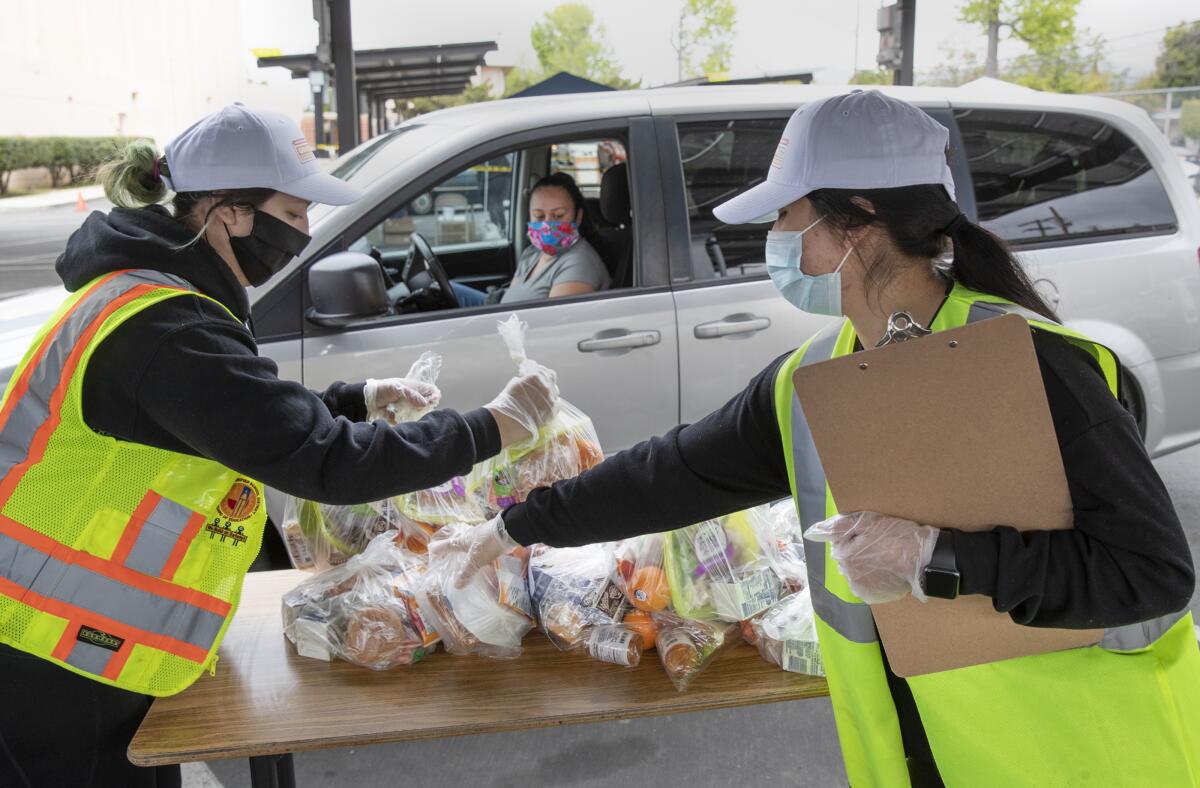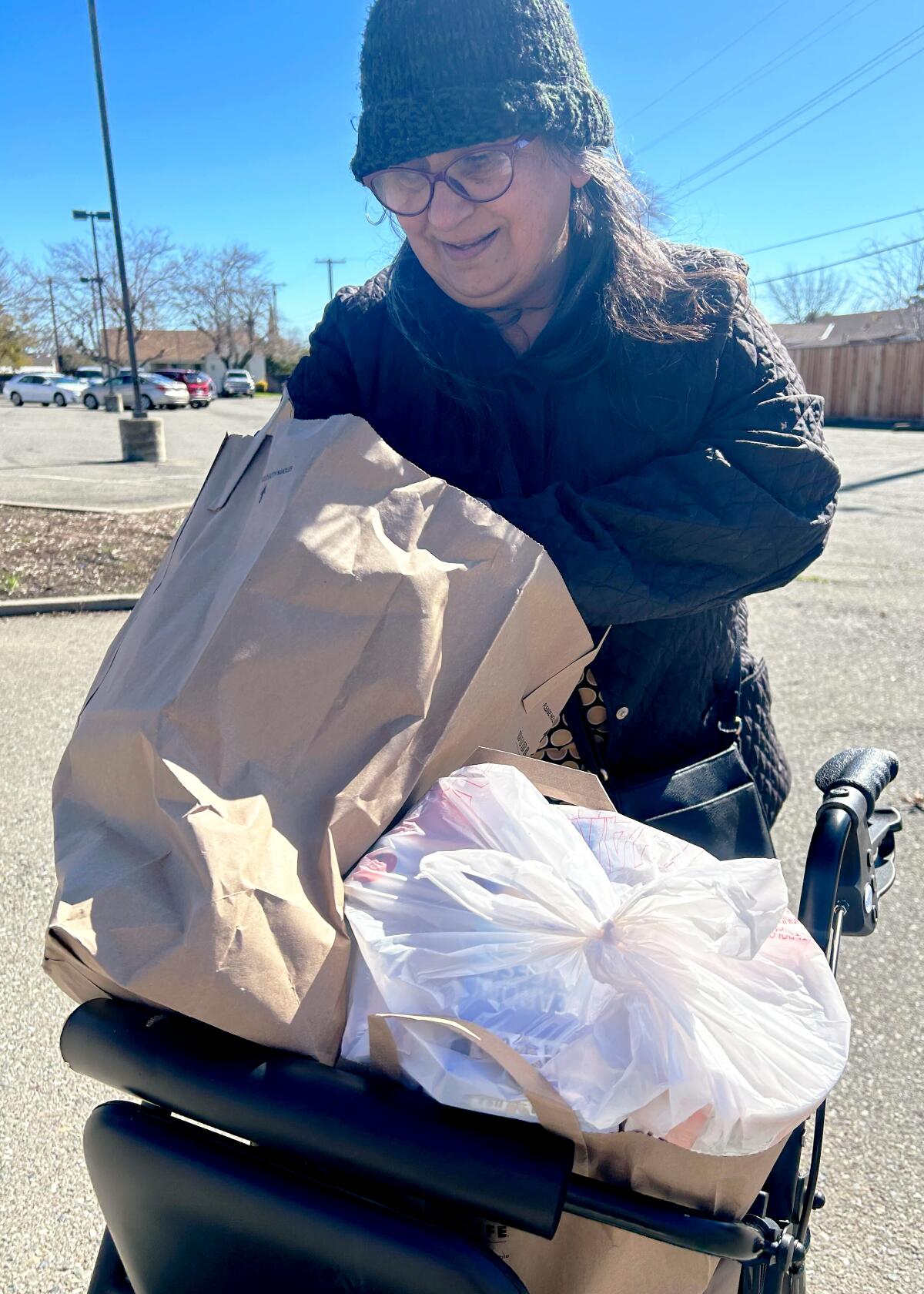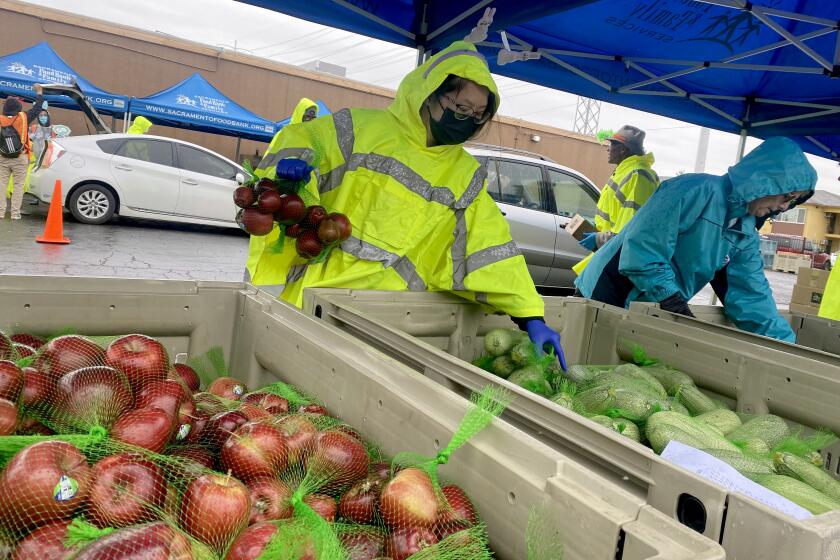Pandemic food benefits are ending for millions of Californians. Now what?

- Share via
SACRAMENTO — Nearly 3 million households in California will stop receiving extra federal food benefits granted during the COVID-19 pandemic, a squeeze on budgets that comes as people continue to struggle with the rising cost of living.
Since March 2020, low-income Californians have seen an increase in CalFresh benefits, the state’s version of the federal Supplemental Nutrition Assistance Program, or SNAP, formerly known as food stamps. But that emergency relief ends this month because Congress voted to terminate the extra benefits as part of the federal omnibus spending plan.
Now, the pressure is on Democratic Gov. Gavin Newsom and state lawmakers to fill the gaps as experts warn of worsening food insecurity and food banks are scrambling to prepare for an influx in clients.
The average CalFresh recipient is expected to lose $82 per month, and the average household about $200 per month. The decrease will be most significant for older Californians, with monthly benefits projected to drop for some from $281 to $23.
A U.S. Department of Agriculture official testified that some of the agency’s food programs are being overburdened in the push to feed needy families.
Delia Priscilla Ortega Darden was standing in line at the South Sacramento Interfaith Partnership food bank on Wednesday in the 48-degree windy weather to collect free groceries after running out of her CalFresh benefits days ago.

Ortega Darden, 64, said she lives in her car after she could no longer work due to health issues including multiple sclerosis. She uses local food banks to make ends meet, but CalFresh benefits — which can be used to purchase fresh fruits and vegetables — are crucial for her health, she said. She uses a walker and said that a better diet has helped with muscle cramps in her legs.
Like nearly 5 million other Californians enrolled in the program, she will see at least a $95 drop in benefits due to the end of the federal emergency allotments. That means she will have to depend more on food banks and places like the Dollar Tree, where she often buys cheap foods like bologna, to get by, she said.
“My whole health has been better because of it,” Ortega Darden said of CalFresh.
While New Jersey Gov. Phil Murphy, a Democrat, signed a bill last month to increase the state’s SNAP minimum benefits in light of the federal cutback, Newsom has so far advised against any big ongoing spending promises, as the state faces a projected$22.5-billion budget deficit.
State Sen. Caroline Menjivar (D-Panorama City) has introduced legislation that would more than double the minimum monthly CalFresh benefit in California from $23 to $50. In New Jersey, the minimum has risen to $95.
Food banks are seeing increased demand as spiking prices at grocery stores and gas pumps due to inflation cut into budgets.
The legislation would be costly to the state — more than $500 million a month. But Menjivar said curbing food insecurity is a preventive measure that ultimately saves the state costs exacerbated by poverty, including costs associated with the homelessness crisis.
While inflation has eased, California remains among the most costly places to live in the nation. Menjivar said that should be considered by Newsom and the Legislature when supporting the state’s safety net programs.
“It intersects into so many different things and can prevent so many different things. It’s about ensuring that our most vulnerable families don’t fall further down into poverty,” she said. “What can you afford right now on $23 a month?”
The state budget proposed by Newsom in January did not reflect the impact of the Consolidated Appropriations Act approved by Congress. Changes to the budget are expected in May. The governor, though, has so far urged caution regarding ongoing spending commitments.
“At this point in the process, we’re not going to make any type of commitment for additional state funds for any number of programs until we have a better sense of what the fiscal picture looks like,” said H.D. Palmer, spokesperson for Newsom’s Department of Finance.
The California Department of Social Services, which has been warning for months about the end of the benefits, pointed to food banks as a solution, saying they are working to be “as prepared as possible for potential increased demand.”
But that’s not enough, said Stacia Hill Levenfeld, CEO of the California Assn. of Food Banks, who called the timing “catastrophic.” The loss of the pandemic food benefits, plus the eventual expiration of electronic benefit transfer cards for low-income children, means a 30% loss to the state’s food safety net, she said.
“There’s no way that food banks alone can fill the gap,” Hill Levenfeld said.
With a potential recession looming, California faces an estimated $25-billion deficit. Lower spending on transportation, housing and education could help close the gap.
Last year, nearly 1 in 4 Los Angeles County residents, about 800,000 households, experienced food insecurity, according to a report released by the USC Dornsife College of Letters, Arts and Sciences.
“The expiration of the emergency boost to the CalFresh program, while inflation and food costs remain high, could push low-income Angelenos to the precipice of a hunger cliff,” said Kayla de la Haye, an associate professor of population and public health sciences at USC’s Keck School of Medicine.
On Tuesday, Newsom officially ended California’s COVID-19 state of emergency. The end of COVID-19 era benefits for low-income families could lead to more attempts at legislation to widen the social safety net.
On Monday, Assemblymember Miguel Santiago (D-Los Angeles) introduced a bill to expand a child tax credit to more low-income families, noting food and rent costs and the need for “essential inflation relief.”
Andrew Cheyne, managing director of public policy for GRACE, an anti-poverty organization, said CalFresh allotments have long been inadequate. Now, people who have become accustomed to years of increased benefits will struggle.
“It’s just really unimaginable to think about the households who will be going to the grocery store expecting to have money in their account and not having what they need to buy groceries,” he said.
“You look at the level of rising food costs over the past year, let alone the rising cost of rent, and know that people were really relying on that amount.”
More to Read
Sign up for Essential California
The most important California stories and recommendations in your inbox every morning.
You may occasionally receive promotional content from the Los Angeles Times.

















